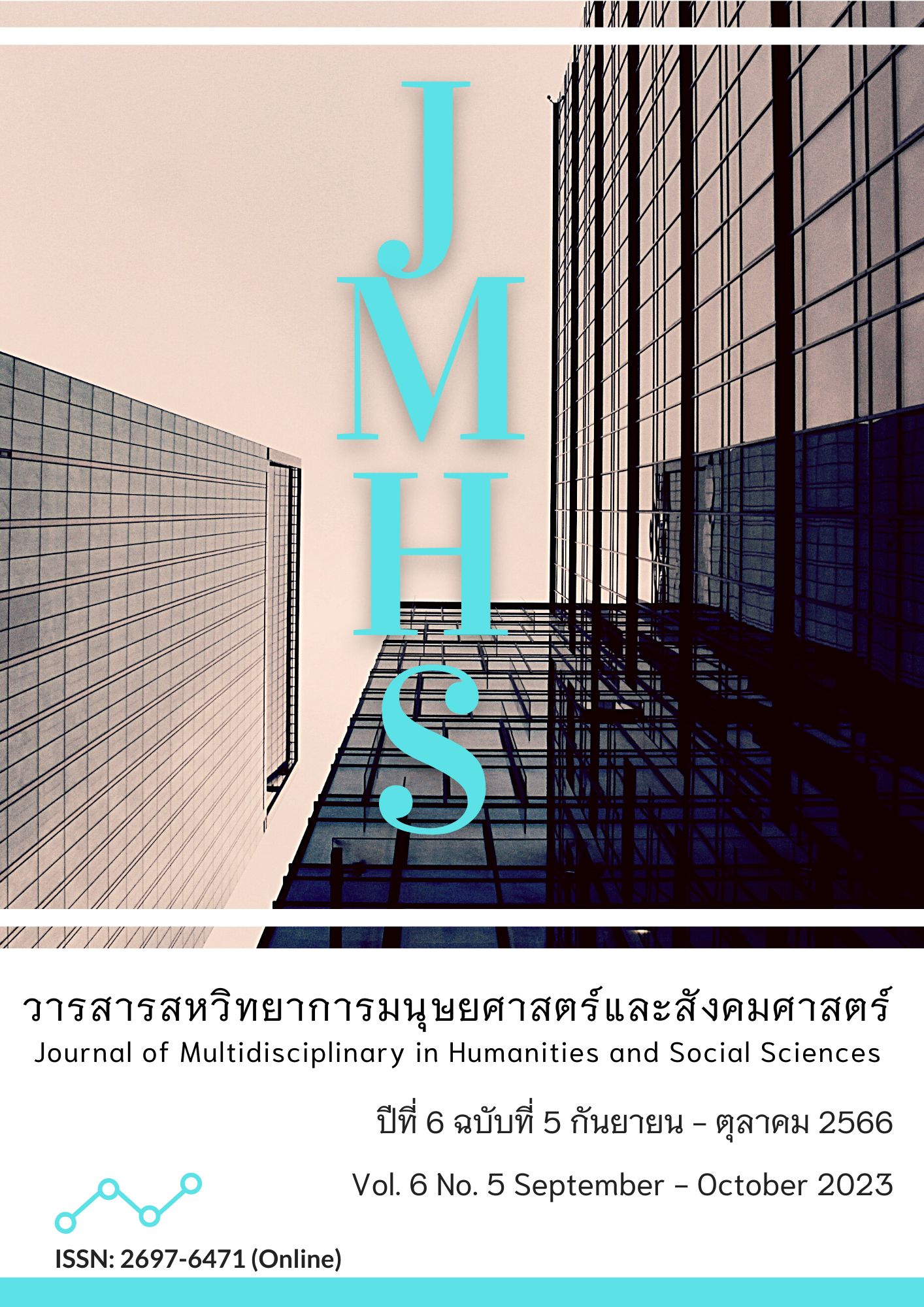Causal Factors Influencing Loyalty to Buy Air Hostess Course on Facebook Page Skycoachmam of Consumers in Thailand
Main Article Content
Abstract
The article aimed to 1) develop and validate a causal relationship model of loyalty to buy air hostess courses on the Facebook page Skycoachmam of consumers in Thailand; and 2) study causal factors affecting the purchase of air hostess courses on the Facebook page Skycoachmam of consumers in Thailand. This study was quantitative research. The sample consisted of 300 people who have bought an air hostess course on their Facebook page, Skycoachmam, and live in Thailand. The tools used in the research were online questionnaires. The statistics used in data analysis were frequency, percentage, confirmatory factor analysis, and structural equation model.
The results of this research were the development of the causal relationship models, which consisted of four components: 1) experience; 2) satisfaction. 3) trust, and 4) loyalty, and the model was consistent with the empirical data to a great extent. The statistics showed CMIN/df = 1.49, GFI = 0.92, AGFI = 0.90, SRMR = 0.03, and RMSEA = 0.04. The final predictive coefficient was 0.73, indicating that the variables in the model can explain the variance of loyalty to buy air hostess courses on the Skycoachmam Facebook page by 73 percent. It was found that experience, satisfaction, and trust were respectively influenced by loyalty. The results of this research were useful for Skycoachmam. The company should create a good experience that creates satisfaction and builds trust for future loyalty.
Article Details

This work is licensed under a Creative Commons Attribution-NonCommercial-NoDerivatives 4.0 International License.
Views and opinions appearing in the Journal it is the responsibility of the author of the article, and does not constitute the view and responsibility of the editorial team.
References
ขนิษฐา เปี่ยมคุ้ม และ มณฑกานติ ชุบชูวงศ์. (2565). ประสบการณ์จากการเข้าร่วมกิจกรรมท่องเที่ยวเชิงสร้างสรรค์ที่ส่งผล ต่อความพึงพอใจและความภักดีของนักท่องเที่ยวชาวไทย กรณีศึกษาชุมชนตำบล บ้านแหลม จังหวัดสุพรรณบุรี. วารสารวิชาการสมาคมสถาบันอุดมศึกษาเอกชนแห่งประเทศไทย, 28(2), 1-14. สืบค้นจาก https://so06.tci-thaijo.org/index.php/apheit-ss/article/view/258777
ชยุตม์กันต์ พงศ์จิรกร และ ทิพย์รัตน์ เลาหวิเชียร. (2561). อิทธิพลของการบริหารประสบการณ์ลูกค้าที่มีผลต่อความภักดีของลูกค้าในธุรกิจคลินิกเสริมความงาม. วารสารบริหารธุรกิจศรีนครินทรวิโรฒ, 9(2), 127-140. สืบค้นจาก https://ejournals.swu.ac.th/index.php /MBASBJ/article/view/10681
ณัฐฐา จินตกวีพันธุ์. (2563). แบบจำลองความสัมพันธ์เชิงสาเหตุของความตั้งใจในการบอกต่อและซื้อสินค้าออนไลน์. วารสารนิเทศศาสตร์, 38(2), 84-104. สืบค้นจาก https://so02.tci-thaijo.org /index.php/jcomm/article/download/237346/164672/840891
ธีรวีร์ วราธรไพบูลย์ และ ปริญ ลักษิตามาศ. (2561). ความสัมพันธ์ระหว่างประสบการณ์ความพึงพอใจ และความภักดีของผู้บริโภคร้านสะดวกซื้อแฟรนไชส์ในประเทศไทย. วารสารปัญญาภิวัฒน์, 10(3), 1-14. สืบค้นจาก https://so01.tci-thaijo.org/index.php/ecbatsu/article/download/167928/136222/
นิธิ นิ่มปรางค์ และ อนุวัต สงสม. (2561). ความสัมพันธ์เชิงสาเหตุระหว่างการยอมรับเทคโนโลยีคุณภาพของเว็บไซต์ ความไว้วางใจ และความภักดีทาง อิเล็กทรอนิกส์: การซื้อสินค้าจากร้านออนไลน์ของผู้บริโภคใน เขตอำเภอเมือง จังหวัดสงขลา. วารสารเศรษฐศาสตร์และบริหารธุรกิจ มหาวิทยาลัยทักษิณ, 11(1), 1-12. สืบค้นจาก https://so01.tci-thaijo.org/index.php/ecbatsu/article/download/167928/136222/
ประสิทธิชัย นรากรณ์ และ ธัมมะทินนา ศรีสุพรรณ. (2561). อิทธิพลของการเผยแพร่ตัวตนในเครือข่ายสังคมออนไลน์อิสระในการใช้งาน การไหลลื่น ความไว้วางใจระหว่างสมาชิกและความภักดีของลูกค้าที่ใช้เฟซบุ๊ก. วารสารมหาวิทยาลัยศิลปากร, 38(2), 586-8489. สืบค้นจาก https://so05.tci-thaijo.org/index.php/sujthai/article/view/121341
พนัชกร สิมะขอรบุญ และ ตติยา คู่มงคลชัย. (2561). ปัจจัยเหตุของความพึงพอใจที่มีต่อความภักดีของลูกค้า: กรณีเว็บไซต์บิวตี้คูล. วารสารอิเล็กทรอนิกส์ บัณฑิตวิทยาลัยมหาวิทยาลัยศิลปากร, 11(3), 1906 -3431. สืบค้นจาก https://he02.tci-thaijo.org/index.php/Veridian-E-Journal/article/view/166069
วรัตถ์นันท์ ศรีเจริญ, ชลธิศ ดาราวงษ์ และ รมิดา วงษ์เวทวณิชย์. (2565). คุณสมบัติของพนักงานขายเครื่องมือแพทย์ที่ส่งผลต่อความพึงพอใจ และความจงรักภักดีของพยาบาลในเขตกรุงเทพมหานคร. วารสารวิชาการศรีปทุม ชลบุรี, 19(2), 1-12. สืบค้นจาก https://www.chonburi.spu.ac.th/journal/index.php?menu=first
ศตวรรษ จำเพียร และ ณัฐพล อัสสะรัตน์. (2562). อิทธิพลของคุณประโยชน์ของเฟซบุ๊กแฟนเพจต่อความเชื่อมั่นและความยึดมั่นในแบรนด์. วารสารบริหารธุรกิจศรีนครินทรวิโรฒ, 41(161), 1-14. สืบค้นจาก https://cbsreview.acc.chula.ac.th/ViewArticle.aspx?ArticleID=62
สมชาย เล็กเจริญ และ ศรัณยู สุวรรณสุนทร. (2565). ปัจจัยเชิงสาเหตุที่มีอิทธิพลต่อความภักดีในการซื้อเครื่องดนตรีสากลบนเพจเฟซบุ๊กในกรุงเทพมหานคร. วารสารศิลปการจัดการ, 6(3), 1-17. สืบค้นจาก https://so02.tci-thaijo.org/index.php/jam/article/download/255683/172923
สุมามาลย์ ปานคํา และ สุภักปรียา แย้มมี. (2564). ปัจจัยเชิงสาเหตุที่มีผลต่อความภักดีในการจองห้องพักบนเว็บไซต์แอร์บีเอ็นบีของผู้บริโภคในประเทศไทย. วารสารศิลปการจัดการ, 5(2), 384-398. สืบค้นจาก https://so02.tci-thaijo.org/index.php/jam/article/view/248032/168373
อ้อมจันทร์ วงศ์วิเศษ. (2561). ปัจจัยส่วนประสมทางการตลาดบริการที่มีอิทธิพลต่อความพึงพอใจของผู้บริโภคในการเลือกใช้บริการธุรกิจออฟฟิศร่วมแบ่งปันในกรุงเทพมหานคร. วารสารมนุษยศาสตร์และสังคมศาสตร์ วไลยอลงกรณ์ ในพระบรมราชูปถัมภ์, 12(3), 1-8. สืบค้นจาก https://so06.tci-thaijo.org/index.php/vrurdihsjournal/article/view/107910
Facebook Page Skycoachmam. (2023). Skycoachmam Background. Retrieved 2023, Jan 1, from https://www.facebook.com/pageskycoachmam
Gokhan, C., & Muge, A. (2015). Examining the Effect of Brand Experience on Consumer Satisfaction, Brand Trust and Brand Loyalty. Journal of Brand Management, 1(2), 101–128. Retrieved from https://www.researchgate.net/publication/298427587
Hair, J. F., Black, W. C., Babin, B. J. & Anderson, R. E. (2010). Multivariate Data Analysis. (7th ed.). Upper Saddle River, NJ: Prentice Hall.
Hair, J. F., Hult, G. T. M., Ringle, C. M., & Sarstedt, M. (2014). A Primer on Partial Least Squares Structural Equation Modeling (PLS-SEM). California, CA: Sage.
Hoelter, J. W. (1983). The Effects of Role Evaluation and Commitment on Identity Salience. Social Psychology Quarterly, 46(2), 140–147. https://doi.org/10.2307/3033850
Hu, L.T., & Bentler, P. M. (1999). Cutoff Criteria for Fit Indexes in Covariance Structure Analysis: Conventional Criteria Versus New Alternatives. Structural Equation Modeling, 6(1), 1–55. https://doi.org/10.1080/10705519909540118
Joreskog, K. G., & Sorbom, D. (1984). Advances in Factor Analysis and Structural Equation Models. Lanham: Rowman & Littlefield.
Kline, R. B. (2011). Principles and Practices of Structural Equation Modeling. (3rd ed.). New York: The Guilford.
Schreiber, J. B., Stage, F. K., King, J., Nora, A., & Barlow, E. A. (2006). Reporting Structural Equation Modeling and Confirmatory Factor Analysis Results: A Review. The Journal of Educational Research, 99(6), 323–337. https://doi.org/10.3200/JOER.99.6.323-338
Schumacker, R. E., & Lomax, R. G. (2004). A Beginner's Guide to Structural Equation Modeling. (2nd ed.). New Jersey: Lawrence Erlbaum Associates.


